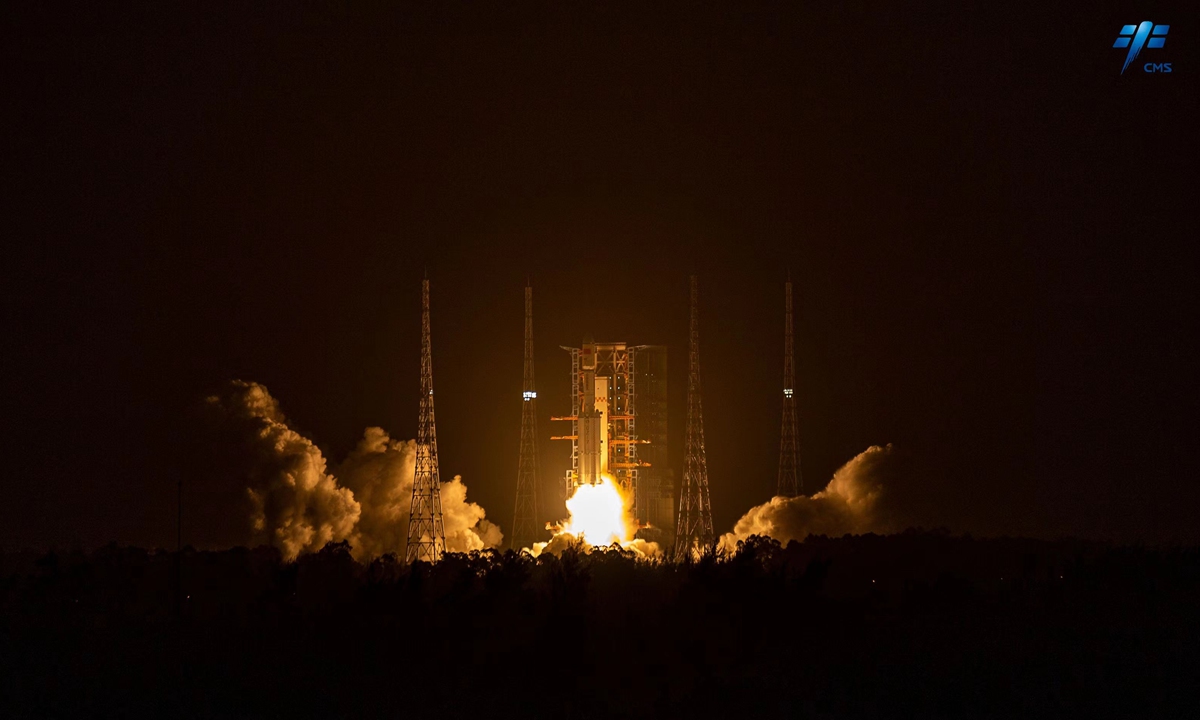Tianzhou-7 successfully launched to supply Tiangong

China's Long March-7 carrier rocket lifts off from the Wenchang Space Launch Site in South China's tropical island province of Hainan on January 17, 2024, carrying Tianzhou-7, currently the world's mightiest cargo spacecraft, to preset orbit. Photo: Courtesy of Liu Zekang
Dear taikonauts, your order on its way, keep an eye out for it! Carrying over 260 items of cargo that weighs about 5.6 tons, China's Tianzhou-7, currently the world's mightiest cargo spacecraft, is sailing toward the China Space Station after an awe-inspiring take-off from a Long March-7 carrier rocket from the Wenchang Space Launch Site in South China's tropical island province of Hainan at 10:27 pm on Wednesday.
According to the China Manned Space Agency (CMSA), after a flight of 10 minutes, the Tianzhou-7 spacecraft entered its preset orbit, marking the full success of the launch mission.
The Wednesday launch mission also marked a first of the four China manned space program missions scheduled for 2024. According to a previous official release, China plans to launch the Shenzhou-18 and Shenzhou-19 crewed missions to the China Space Station in 2024, along with the two planned cargo runs to the Chinese permanent space outpost.
Orbiting Earth about 400 kilometers above the ground, the China Space Station, which is also known as Tiangong, meaning the heavenly palace, has three permanent parts — a core module and two science capsules — and is regularly connected to several visiting crew and cargo spaceships.
The Long March-7 rocket is a new generation medium-lift launch vehicle developed to meet the needs of launching cargo spacecraft for the China Space Station.
It has a low Earth orbit carrying capacity of 14 tons and is affectionately referred to as the "space station cargo express." Wednesday's launch marks the seventh joint venture of the Long March-7 rocket with the Tianzhou cargo spacecraft into space, the Global Times learned from the rocket developer China Academy of Launch Vehicle Technology (CALT).
In the second half of 2024, the Long March-7 rocket will also launch the Tianzhou-8 cargo spacecraft, and will also launch other satellites using the expedition upper stage, according to the academy.
Zhou Ning, a member of the Long March-7 launching team with the CALT, said that the team has always strived for "continuous optimization." The comprehensive performance of the rocket's systems has been continuously enhanced, and the testing and launching cycle has been reduced from the initial 38 days to the current 25 days, according to Zhou.
The launch on Wednesday marked the 507th flight of the Long March rocket class.
The Tianzhou-7 cargo spacecraft is the seventh of its kind developed by the China Academy of Spacecraft Technology (CAST,) and it carries over 260 items of cargo weighing approximately 5.6 tons, Li Zhiyong, an engineer with the CAST, said on Wednesday.
The Tianzhou-7 cargo spacecraft is loaded with experimental payloads, custom cargo packages, and other large items, each weighing over 100 kilograms. These are used for the space station's in-orbit operation, space in-orbit scientific experiments, and taikonaut life support.
It includes 2,400 kilograms of living essentials for taikonauts including special goods for the upcoming Chinese New Year of the Dragon, fresh fruit, vegetables, and gift packages. The packaging design has been optimized for longer storage time and fresher contents.
Tianzhou-7 is an upgraded model of fully sealed cargo spacecraft, possessing the world's largest active cargo transportation capacity, the highest freight efficiency, and the most comprehensive in-orbit support capabilities, Li told the Global Times.
While ensuring a stable performance of the spacecraft, we have also carried out some system upgrades to the Tianzhou, such as enabling it to conduct an ultrafast rendezvous and docking with the China Space Station, the CAST expert explained.
After entering orbit, Tianzhou-7 will use a rapid rendezvous and docking approach, and dock at the rear port of the Tianhe space station core module to form a combined structure in only three hours, which is considerably shorter than the conventional 6.5 hours, he explained.
This optimized approach offers greater flexibility and a wider range of adaptability, further enhancing the cargo spacecraft's autonomous rendezvous and docking capabilities. This also enriches the modes of rendezvous and docking, further advancing the development of rendezvous and docking technology, Li hailed.
To support the continuous rollout of space experiments aboard the China Space Station, Tianzhou-7 mission will deliver new experimental payloads, experimental units and samples, experimental consumables, spare parts, and other application materials for in-orbit experiments, said Liu Wei, chief designer of the space application system for the Tianzhou-7 mission.
With the Tianzhou-7 mission, the space application system plans to send 16 standard cargo packages, one set of cell life support devices, and one set of 4 C microfluidic chips to the space station. In total, there will be 61 sets of products, weighing approximately 473 kilograms, to be sent to the Tiangong, according to Liu.
After these application materials are transported to the space station, they will be transferred to the experimental facilities onboard for conducting 33 scientific experiments in areas such as space life science, space materials science, microgravity, fluid physics, and combustion science, Liu noted.
Photos
Related Stories
- New scientific experimental samples from China's space station return to Earth
- Nation open to sharing lunar samples in fair, equal manner
- 2023 in review: A fruitful year for China's manned space program
- China sends four meteorological satellites into space
- 2023 Yearender: China's commercial space industry delivers unprecedented progress
- China eyes launching low-cost cargo spacecraft for space station through commercial rocket
Copyright © 2024 People's Daily Online. All Rights Reserved.









